 |
 |
 |
| |
Effect of initiating antiretroviral therapy on markers of monocyte activation, endothelial dysfunction and platelet activation in HIV-1 infection
|
| |
| |
Reported by Jules Levin
16th International Workshop on Co-morbidities and Adverse Drug Reactions in HIV 6 October 2014, Philadelphia USA
JA O'Halloran1, 2, E Dunne3, MMP Gurwith1, JS Lambert1, 2, GJ Sheehan2, ER Feeney1, A Pozniak4, P Reiss5, D Kenny3, PWG Mallon1, 2
1HIV Molecular Research Group, School of Medicine and Medical Science, University College Dublin, Dublin, Ireland
2Department of Infectious Diseases, Mater Misericordiae University Hospital, Dublin, Ireland
3Cardiovascular Biology Group, Royal College of Surgeons in Ireland, Dublin, Ireland
4 HIV Directorate, Chelsea and Westminster Hospital NHS Foundation Trust, London, United Kingdom
5 University of Amsterdam, Academic Medical Center, Department of Global Health and Stichting HIV Monitoring, Amsterdam, Netherlands
"authors program abstract - Conclusions: Markers of monocyte activation, endothelial dysfunction and platelet activation are significantly higher in subjects with untreated HIV compared to matched HIV-negative controls. Initiation of ART results in reductions of these markers. However, endothelial dysfunction and monocyte activation markers do not normalize and sCD14 in particular is not appreciably impacted by ART initiation. This points to a persistent pro-atherogenic biomarker pattern despite effective control of HIV viraemia."
"Untreated HIV infection is characterised by a pro-atherogenic inflammatory milieu that is reflected by the pattern of monocyte, endothelial and platelet activation ART initiation fails to fully correct these abnormalities ......Cardiovascular disease is the leading cause of death in persons living with HIV on effective ART......We aimed to explore changes in markers of monocyte activation, endothelial function and platelet function with initiation of ART. ·Both sCD14 & sCD163 were significantly higher in untreated HIV+ subjects compared to HIV- controls......ART initiation resulted in significant reductions in sCD163.....No effect on sCD14 with ART initiation.....Pre-ART, lower CD4 T-cell counts correlated with higher monocyte activation......Measured I-FABP - measure of microbial gut translocation.....No significant between-group difference in pre-ART I-FABP......I-FABP significantly increased, rather than decreased post ART initiation.....Significant reductions in all endothelial markers post ART initiation.....Remained higher than control values at week 12"
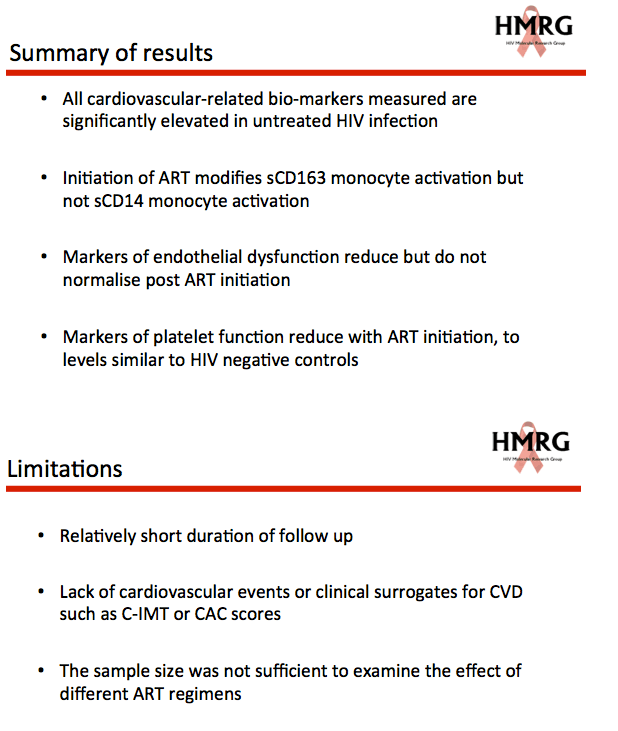
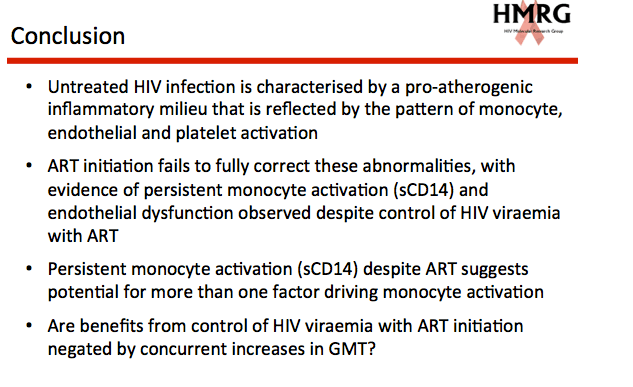
Program abstract:
Effect of initiating antiretroviral therapy on markers of monocyte activation, endothelial dysfunction and platelet activation in HIV-1 infection
JA O'Halloran1,2, E Dunne3, MMP Gurwith1, JS Lambert1,2, GJ Sheehan2, ER Feeney1, A Pozniak4, P Reiss5, D Kenny3, PWG Mallon1,2
1HIV Molecular Research Group, School of Medicine and Medical Science, University College Dublin, Dublin, Ireland; 2Department of Infectious Diseases, Mater Misericordiae University Hospital, Dublin, Ireland; 3Cardiovascular Biology Group, Royal College of Surgeons in Ireland, Dublin, Ireland; 4HIV Directorate, Chelsea and Westminster Hospital NHS Foundation Trust, London, United Kingdom; 5University of Amsterdam, Academic Medical Center, Department of Global Health and Stichting HIV Monitoring, Amsterdam, the Netherlands
Aim: Higher rates of cardiovascular disease are reported in persons living with HIV-1 infection, with immune activation, endothelial dysfunction and platelet activation all potentially contributing to this increase. We aimed to examine the effects of ART initiation on markers of all three processes.
Methods: Markers of monocyte activation (sCD14, sCD163), endothelial dysfunction (vWF, ICAM-1, VCAM-1) and platelet activation (sP-Selectin, sCD40L, sGPVI) were measured at baseline, 4 and 12 weeks post-ART initiation in HIV-positive subjects and compared with HIV-negative controls matched for age, gender, race and smoking status. Data are median (IQR).
Results: Twenty-five HIV-1-positive subjects not on ART (baseline CD4+ T-cell count 318 [235, 433] cells/cm3; log HIV RNA 4.39 [4.16, 4.70]) and 15 HIV-negative matched controls were recruited. In untreated HIV-positive subjects, sCD14 and sCD163 were significantly higher than in HIV-negative controls (1,570 [1,287, 2,102] vs 878 [695, 1,091] ng/ml, P<0.0001; 1,486 [1,184, 1,910] vs 621 [406, 700] ng/ml, P<0.0001 respectively).
ART initiation resulted in a significant decrease in sCD163 at week 12 (1,005 [791, 1,577] ng/ml, P=0.001), although levels remained significantly higher than in HIV-negative controls (P<0.0001) whereas levels of sCD14 remained unchanged. All three markers of endothelial dysfunction were significantly higher in HIV-positive subjects than in controls (vWF 731 [458, 1,227] vs 343 [314, 385] mU/ml, P=0.0003; ICAM-1 770 [569, 928] vs 408 [333, 606] ng/ml, P<0.0001; VCAM-1 854 [714, 1,114] vs 456 [286, 507] ng/ml, P<0.0001) and decreased by week 12 but remained significantly higher compared to controls.
Platelet activation markers were significantly higher than HIV-negative controls (sGPVI 6.6 [4.8, 8.3] vs 4.0 [2.2, 4.9] ng/ml, P=0.003; sCD40L 273 [148, 350] vs 77 [62, 121] ng/ml, P<0.0001; sPselectin 50 [37, 61] vs 40 [29, 49] ng/ml, P=0.04) and also reduced significantly after ART initiation (4.9 [4.0, 7.0] ng/ml, P=0.03; 121 [88, 229] ng/ml, P=0.002; 34 [27, 53] ng/ml, P=0.001, respectively) reaching levels comparable to those observed in the HIV-negative group at 12 weeks post-ART initiation. Change in log HIV RNA strongly correlated with change in all three markers of platelet activation (sGPVI r=0.52, P=0.01; sCD40L r=0.59, P=0.004; sP-selectin r=0.67, P=0.001).
Conclusions: Markers of monocyte activation, endothelial dysfunction and platelet activation are significantly higher in subjects with untreated HIV compared to matched HIV-negative controls. Initiation of ART results in reductions of these markers. However, endothelial dysfunction and monocyte activation markers do not normalize and sCD14 in particular is not appreciably impacted by ART initiation. This points to a persistent pro-atherogenic biomarker pattern despite effective control of HIV viraemia.
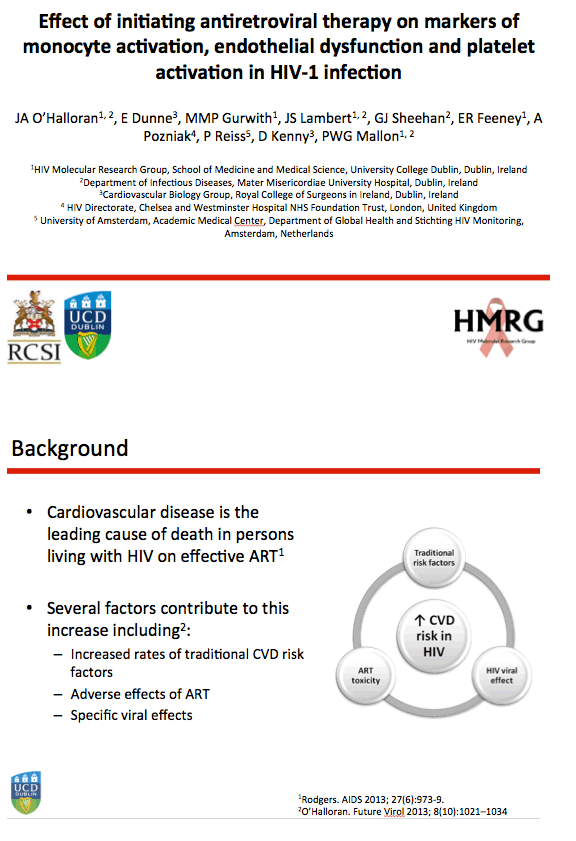
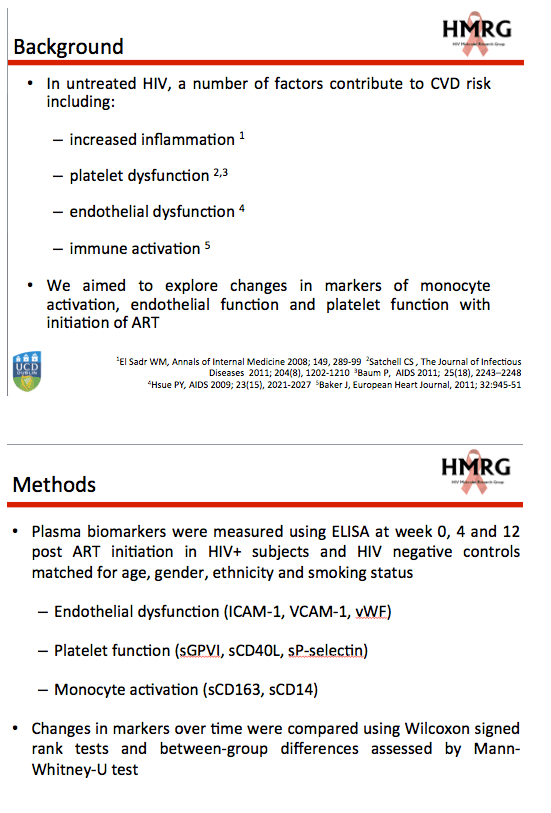
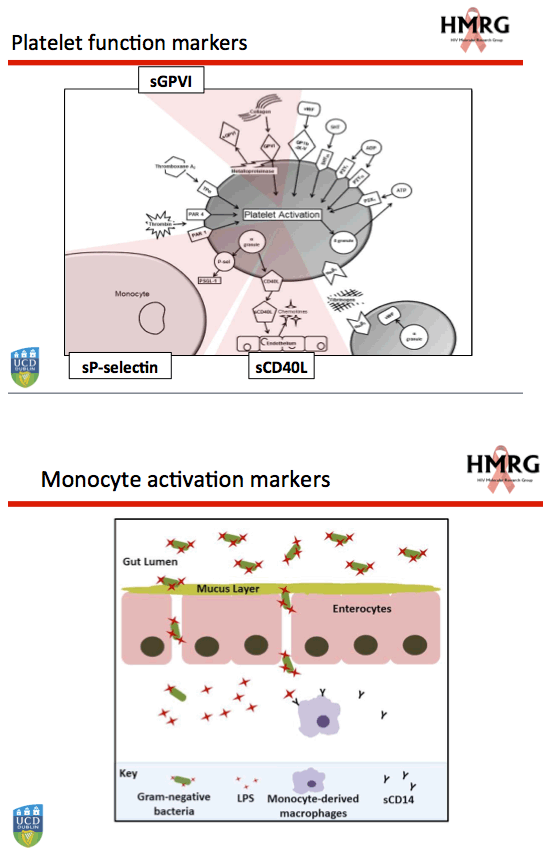
Increased sCD14 is produced when lipopolysaccaride, a major component of the cell wall of gram negative bacteria, binds to CD14+ monocytes and has been suggested to reflect monocyte activation mediated by gut microbial translocation. In contrast, sCD163, another marker of monocyte activation reflects expansion of CD14+CD16+ monocytes, a monocyte subset considered to be among the most atherogenic and which is increased in symptomatic CVD in the general population. This subset is known to expand in HIV infection relative to the 'classical' CD14+CD16- monocyte subset
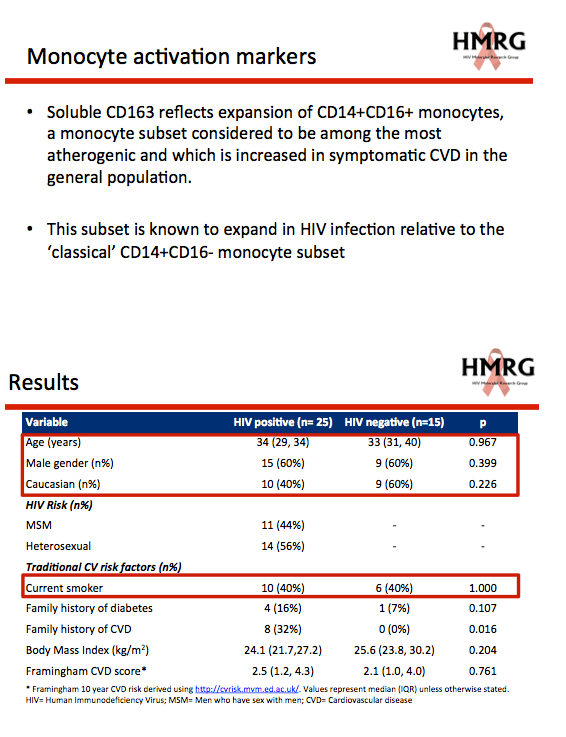

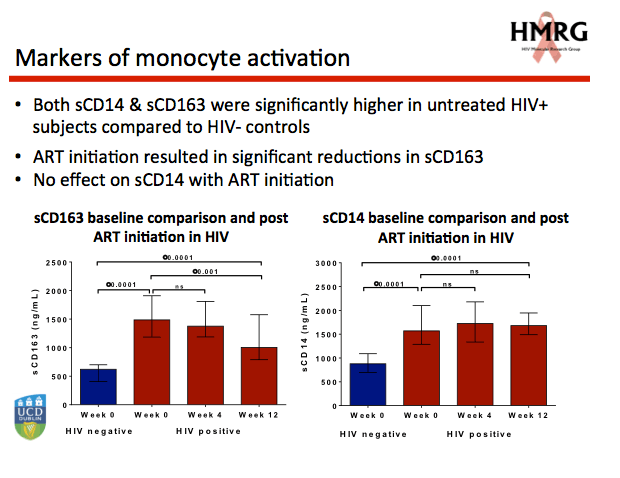
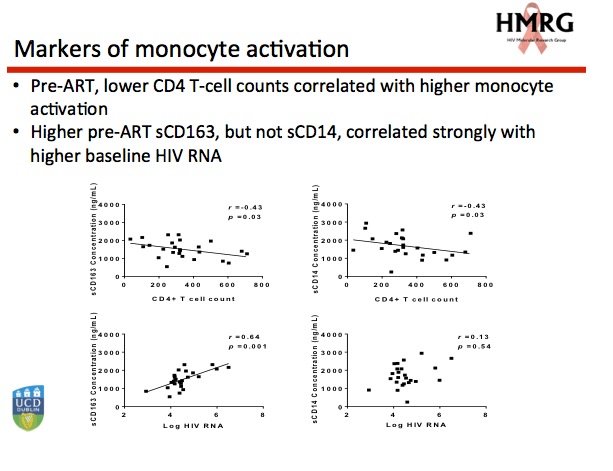
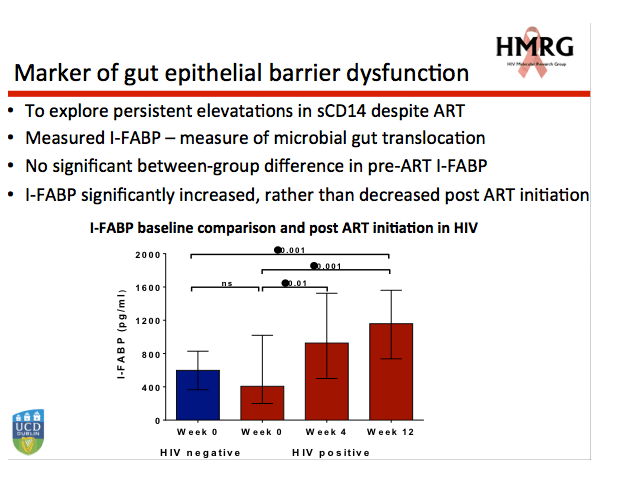
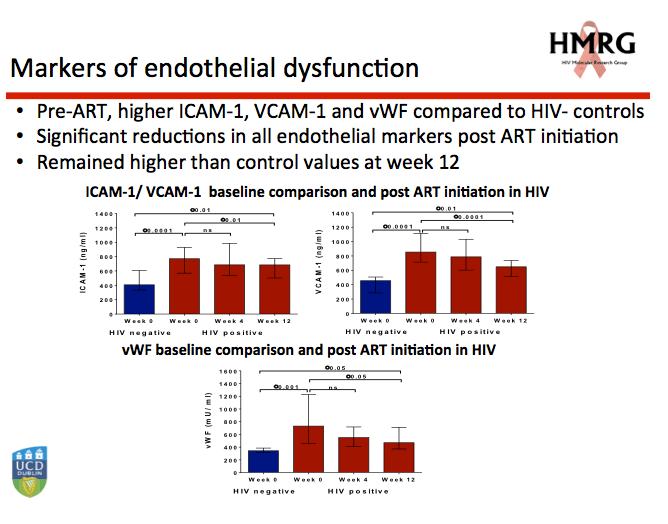
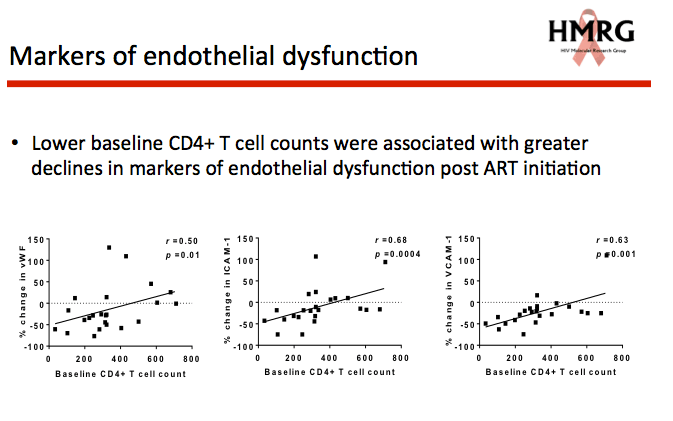
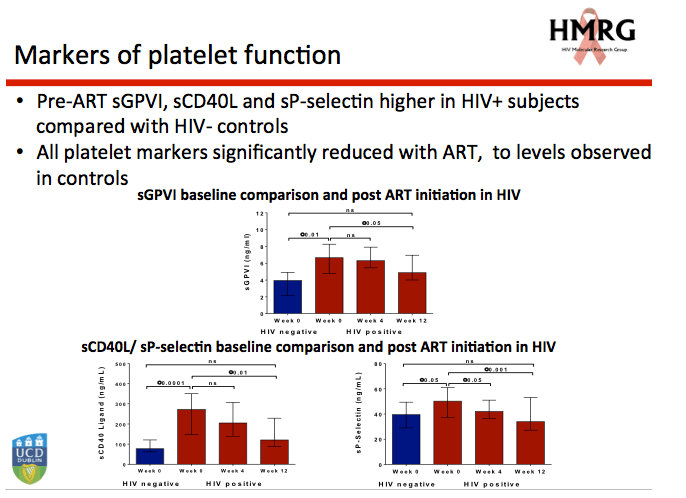
P-selectin, which interacts with P-selectin glycoprotein ligand-1(PSGL-1) on leukocytes (preferentially monocytes) to form PMC and CD40 ligand, which promotes platelet-leukocyte adhesion through interaction with CD40, also found on monocytes and endothelial cells, play an important role in the formation of these platelet- monocyte aggregates
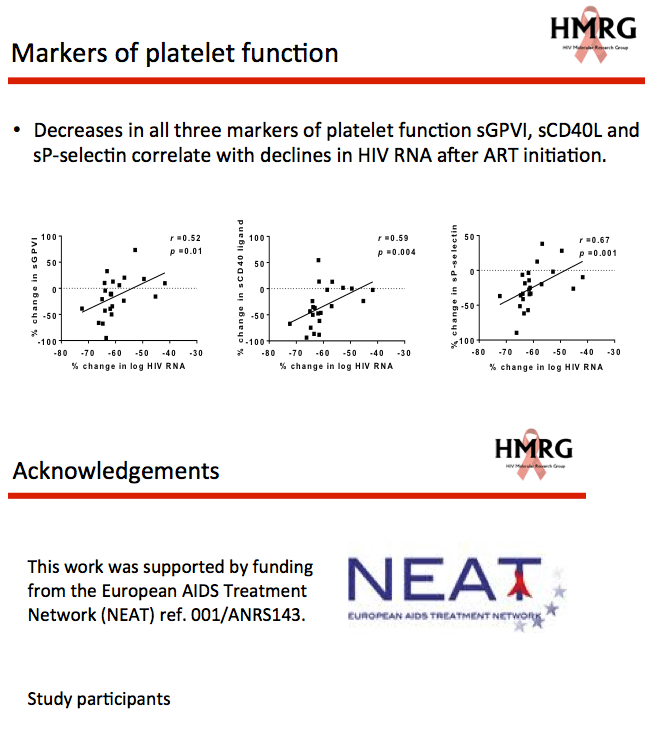
|
| |
|
 |
 |
|
|